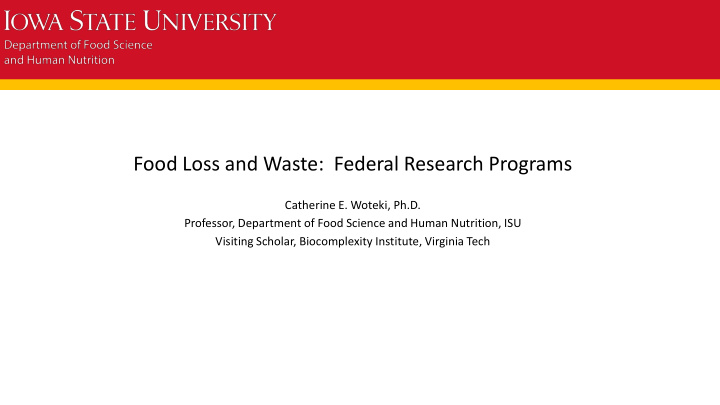



Food Loss and Waste: Federal Research Programs Catherine E. Woteki, Ph.D. Professor, Department of Food Science and Human Nutrition, ISU Visiting Scholar, Biocomplexity Institute, Virginia Tech
The Feder eral Go Gover ernmen ent’s Interes est U.S. Department of Agriculture What share of the food supply is lost or wasted? How can loss or waste be reduced? Environmental Protection Agency What are the environmental impacts of wasted food? How can food waste be reduced?
ER ERS and EP EPA D A Definitions USDA/ERS Food loss represents the edible amount of food, postharvest, that is available for human consumption but is not consumed for any reason. cooking loss and natural shrinkage (e.g., moisture loss); • loss from mold, pests, or inadequate climate control; • food waste • Food waste is a component of food loss and occurs when an edible item goes unconsumed food discarded by retailers due to color or appearance and • plate waste by consumers. • EPA • Food Waste Uneaten food and food preparation wastes from residences and commercial establishments such as grocery stores, restaurants, and produce stands, institutional cafeterias... •
Commodity supply and disappearance flowchart
Annual food loss of top three food groups measured by amount, value, and calories SOURCE: Buzby, Wells, and Aulakh (2014).
Hi Histor ory Food “disappearance” historical data series--1907 Now called “availability” • Data have multiple applications • Garbalogy Gail G. Harrison, William L. Rathje, Wilson W. Hughes. 1975. Food waste behavior in an urban population. J. Nutr Ed and Behavior 7(1):13-16. sample of about 300 households studied over periods of several months • 1973 and 1974 • average household wasted between $80 and $100 worth of food per year • (exclusive of food waste which was poured down the drain, ground up in garbage disposals, fed to household pets, composted, or disposed of other than in the garbage can)
Issues in W Waste R Research Multiple contributors to food loss/waste: Overplanting of crops to guarantee supply • Edible crops left in the field due to diminishing returns on investments in harvesting • Damage, contamination, or inefficiencies in harvest, storage, processing, and distribution • High cosmetic standards leading to culling of visually imperfect products • Overstocked product displays at stores • Inconsistent date labels that confuse consumers, leading to premature disposal • Over-preparation, large portion sizes, and aversion to eating leftovers • Lack of awareness about the occurrence and impacts of food waste • Observer/Hawthorne Effect individuals modify an aspect of their behavior in response to their awareness of being observed •
Curr rrent R Research USDA/Office of the Chief Economist USDA/EPA Food Waste Challenge • Inventory of USDA food loss and waste reduction activities • USDA/NIFA AFRI Programs • Global Food Security • Improving Food Quality • Childhood Obesity Prevention • 1890’s Capacity Building Program • Small Business Innovation Research Program • Specialty Crops Research Initiative • Agriculture Marketing Program •
Curr rrent R Research USDA/ERS NAS/CNSTAT 2015 report: Data and Research to Improve the U.S. Food Availability System and Estimates of Food Loss Improved methods: How to improve the estimates of food loss? • USDA/ARS Alliance for Food Security through Reduction of Postharvest Loss and Food Waste • National Program 306: Quality and Utilization of Agricultural Products 2015-2019 • (non-food, non-fuel biobased products) National Program 214: Agricultural and Industrial Byproducts • National Program 216: Agricultural Systems Competitiveness and Sustainability • National Program 107: Human Nutrition •
Conta ntacts Office of the Chief Economist: Dr. Elise Golan Economic Research Service: Dr. Ruth Buzby National Institute of Food and Agriculture: Program managers Agricultural Research Service: Dr. Pam Starke-Reed (Nutrition) And thanks for listening!
Recommend
More recommend